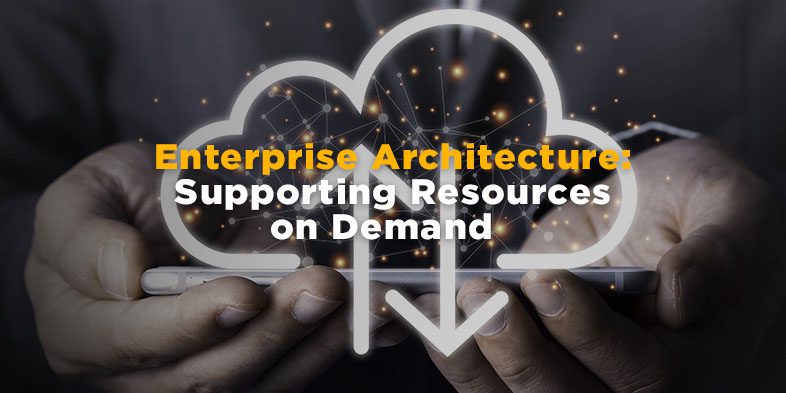Enterprise Architecture: Supporting Resources on Demand


As part of Solutions Review’s Contributed Content Series—a collection of contributed articles written by our enterprise tech thought leader community—Adonay Cervantes, the Global Field CTO at CloudBlue, explains how selling enterprise architecture (EA) as a subscription can help companies receive the resources they need.
 Just as streaming platforms like Netflix revolutionized entertainment, selling enterprise architecture (EA) as a subscription service is transforming how businesses access, utilize, and leverage cutting-edge resources. From a technology perspective, we refer to EA as the infrastructure, application, and management of IT components.
Just as streaming platforms like Netflix revolutionized entertainment, selling enterprise architecture (EA) as a subscription service is transforming how businesses access, utilize, and leverage cutting-edge resources. From a technology perspective, we refer to EA as the infrastructure, application, and management of IT components.
The subscription economy is changing how organizations run applications and reshaping how industries approach innovation and growth in a more inclusive, sustainable, and flexible manner. Small and medium-sized businesses now have access to tools and resources that were previously out of reach. As this trend continues, companies must adapt and capitalize on opportunities while navigating various challenges, such as security.
Democratizing Technical Innovations
Gone are the days when businesses needed to make enormous initial investments in hardware infrastructure, followed by the time-consuming process of setting up and maintaining the required technology. Public and private clouds have enabled businesses to access advanced computing power, storage capabilities, and data management tools on a pay-as-you-go basis. This shift has opened the doors to companies that might have been limited by budget constraints and lack of expertise.
In the software-as-a-service (SaaS) industry, infrastructure operations are a critical part of delivering reliable software services to customers. Many SaaS companies also rely on third-party service providers to handle some or all of their infrastructure, leveraging the know-how and resources of these providers to optimize their operations and improve the quality of their services.
SaaS platforms typically provide subscriptions so companies can pay for what they use while receiving regular updates and new features. This allows small and medium-sized businesses to gain access to tools and capabilities that were once the exclusive domain of tech giants. Smaller players are empowered to utilize complex applications without draining in-house resources or requiring large upfront costs.
As a business customer, you can acquire subscriptions tailored to your specific needs, allowing you to access resources for a designated period. This flexibility reduces financial strain and offers the agility necessary to keep up with and respond to market fluctuations.
Managing Resources Wisely
Service providers can offer infrastructure to help you scale and respond to customer demand. They help determine the appropriate resources needed to fulfill business objectives while avoiding unnecessary expenses.
Businesses often experience periods of increased demand, such as during the holiday shopping season. Managed service providers (MSPs) help anticipate and respond to these spikes in demand and plan for additional resources to ensure smooth operations during peak times. In turn, you can scale down resources during non-peak times while maintaining your subscription services.
As you define your business goals, MSPs work to understand these objectives and tailor the technical architecture to achieve these goals efficiently. You do not want to spend more than you need using all these components. This includes calculating the appropriate number of servers, databases, and other resources necessary to handle the workload efficiently.
Economic and Environmental Sustainability
Beyond streamlining business operations, selling enterprise architecture as a subscription service can also reduce energy consumption as companies scale on demand. The traditional investing model in on-premises infrastructure often resulted in overprovisioning, where businesses had to predict their peak resource needs and invest accordingly. This led to wasted capacity during non-peak times.
The subscription model, on the other hand, allows for resource scaling based on actual demand. Computing power can be utilized more effectively, reducing the need for redundant hardware and lowering energy consumption. Cloud computing is more energy-efficient and has 98 percent lower greenhouse gas emissions than on-premises data centers.
Reshaping Industries Through Subscriptions
The global enterprise architecture market is expected to grow to over $1741 million by 2028. While the subscription-based EA model holds great promise, there are best practices to consider when implementing this strategy.
Businesses must ensure data security and privacy, selecting experienced providers with strong security measures. When you work with a third-party vendor, you should ensure they have contingency plans to address service disruptions. As the subscription economy grows, the market could become saturated with providers offering varying levels of service quality. Businesses should carefully evaluate their options, considering factors such as customer support, scalability, and the sophistication of available resources.
However, the positive impact of selling enterprise architecture as a subscription service is clear. More service providers offering cloud solutions create more competition for your business. You, as the business customer, have more options, which can lead to better services and pricing.
Business customers of all sizes can access advanced technology and data storage capabilities through a subscription. This can open economic doors to developing nations, allowing business growth to more players who would otherwise not be able to participate in a digital transformation journey. This fosters a more inclusive and diverse tech landscape, where breakthroughs can emerge from unexpected corners of the business world.
You can focus on growing your core business without the traditional burdens of upfront investment and the complexity of building and managing infrastructure from scratch. By providing access to technological resources, selling enterprise architecture on a subscription basis, like Netflix, is driving change across industries.




















